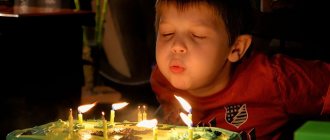Theories and methods of speech development in preschool children
Studying speech is an important part of the educational process and the mental education of a child. Language proficiency is considered an important criterion for readiness for the school curriculum.
In accordance with the Federal State Educational Standard, preschool methods of speech development should be aimed at achieving the following goals:
- formation of free communication of children with each other;
- vocabulary development;
- hearing development;
- studying literature.
Development methods in preschool educational institutions
Methods for teaching speech development should be aimed at achieving the child’s ability to freely express his thoughts and desires, maintain a conversation with both peers and adults, and develop creative skills and abilities.
Types of modern techniques
There are a large number of modern methods of speech development. Most often, work in kindergarten is based on methodological textbooks by V. I. Yashina, M. M. Alekseeva and L. P. Fedorenko.
The theory and methodology of speech development in preschool children by the authors Yashina and Alekseeva are popular due to the clear phasing of tasks. The program includes the following:
- vocabulary replenishment;
- formation of competent perception of sounds;
- development of skills to construct sentences;
- teaching connected storytelling.
Modern methods involve the active use of visual techniques, showing paintings, photographs, and conducting conversations. Theatrical skits and drawing lessons play a big role in the development of speech in preschoolers. In older groups, the focus is on identifying violations and correcting them.
Forms of training
Stages of speech development
Knowledge of the world around us begins from birth. It is during this period that the foundations of speech are laid. A child's first conscious words can be heard at the age of one year. The accumulation of vocabulary begins and pronunciation improves. Every day the baby will reveal something new.
At the age of three years, the baby pronounces simple sentences, he is able to talk about what he saw and express his desires. By the age of five, the vocabulary is actively expanding, children sing songs and recite poems.
Stages of development
Speech development methods
The method of speech development in pedagogy is understood as a method of activity of a teacher aimed at developing speech skills.
Methods and techniques are classified depending on the materials used in the work and the nature of cognitive activity.
How to get into a speech therapy group in kindergarten
There are three main methods:
- visual;
- verbal;
- practical.
Many teachers consider this division to be conditional, since there is no clear boundary between them. All three methods should work interconnected.
In kindergarten, visual methods are most often used. They are divided into indirect and direct. The second group includes excursions and inspections of premises. Activities are aimed at accumulating vocabulary.
Verbal methods include reading fiction, memorizing poetry, and retelling. This should be accompanied by visual techniques, since preschool age necessarily requires visualization.
Practical methods consist of the use of didactic materials, games, and performances of skits.
Basic methods
Stages of speech development in children from birth to school
Human speech develops in stages. Its formation begins from birth. Russian psychologist and linguist Alexey Leontiev identified a number of important stages of speech formation that a child goes through: preparatory, pre-school and pre-school.
The preparatory period covers the period of time from birth to one year, it is divided into 3 stages:
- scream _ With its help, the newborn communicates with the people around him. This is the first vocal reaction. The child uses it to tell his mother about his discomfort. Thanks to screaming, articulation, voice, and breathing are trained;
- revelry _ Lasts until six months of age. The baby reproduces certain sounds and their variations (a-gy, boo-oo, a-gu). At this stage, it is important to support the child's desire to communicate. To do this, parents should repeat what the baby says;
- babble _ This stage lasts up to a year. It is the final stage of preparing the baby for full speech. Children begin to pronounce repeated syllables (ma-ma, va-va, ba-ba, yes-da, pa-pa). At first, the child pronounces simple words unconsciously. But by 10-12 months, children begin to meaningfully use “ma-ma”, “ba-ba”, etc.
The pre-school stage begins when infants begin to consciously pronounce their first words. It lasts from 12 months to 3 years. Children's first words are general in nature. For example, “give” can mean a request, a desire, or an object. Therefore, only family members understand the baby for now.
From the age of one and a half years, children begin to pronounce words in full, and not in a truncated form. The lexicon continues to expand. Kids try to put simple words into sentences without prepositions. For example, “Masha am-am” means that Masha is hungry. By the age of three, questions are formulated in speech: “How?”, “Where?”, “Where?”, “When?”.
Children under three years old actively use gestures
The child learns to use prepositions, agree words in case, number, gender. Four-year-old children already communicate using complex and compound sentences. The preschool stage of speech formation lasts from 3 to 7 years. This is a time of active replenishment of the vocabulary.
By the end of the preschool period, children pronounce all sounds correctly and have a broad outlook.
Ways for teachers to teach children competent speech
Teachers play a major role in the development of speech in preschool children. In this regard, special requirements are placed on teachers’ speech culture. Communication between educators and children occurs both at the everyday level and in terms of the curriculum. The potential of the speech environment of preschool children depends directly on the quality of the teacher’s speech.
Goals and objectives of speech formation in preschoolers
The goal of speech development in preschool age is the formation of correct and competent speech, taking into account age-related characteristics. In the theory of pedagogy, there are three aspects of speech development tasks:
- structural - based on the formation of the phonetic, grammatical and lexical language level;
- communicative - development of language skills, communicative functions, the ability to connect sentences into a coherent story, knowledge of forms of communication;
- cognitive or cognitive - this aspect forms the ability to understand the phenomena of speech and language.
Important! The main work on speech development should be carried out in the direction of developing oral communication skills. The level of speech education is closely related to the development of thinking, the formation of the foundations of morality and aesthetics.
Speech therapy classes in the garden
Creating conditions for children to develop correct sound pronunciation skills
Parents and educators must be aware of the responsibility for instilling purity of speech in children from the early days of life. All age-related deviations in pronunciation disappear in children by the age of five. But the process cannot happen on its own. Coherent and competent speech is formed by the example of adults.
Teachers and parents are obliged to create conditions in which the child will hear only literate speech. The environment is also very important. You can’t babysit with your baby in the family. This method of communication will lead to the development of incorrect sound pronunciation.
Important! Parents often make a big mistake. In order to educate the child, they force him to memorize complex and long poems. This leads to overload. Such a remedy can only worsen pronunciation problems. Any activity should be appropriate for the child’s age and be interesting to him.
Producing vowel sounds in children
Kindergarten teachers must monitor the process of children developing competent pronunciation from an early age. Observations must be made during the learning project, both in class and on outings. In the general system of work, games, reading fairy tales, poems, and holding conversations occupy an important place.
Creating a natural environment in the garden
Principles for identifying violations and correcting them
In the process of observing children and analyzing their pronunciations, teachers use a diagnostic method to identify violations.
The basic principles of correction of speech disorders include the following:
- systematic - when conducting diagnostics, it is necessary to influence all components of speech, including structure;
- development principle - it is important to identify the main violation and direct all work to it;
- complexity - work on speech therapy should be carried out in conjunction with medical and psychological influence;
- the principle of the relationship between speech and psychology - a speech therapist must correct those developmental deviations that interfere with the proper functioning of speech activity.
Practical and verbal methods are used to correct sound pronunciation.
Analysis of children's pronunciation
Speech exercises
To develop speech, it is recommended to perform special exercises. Classes can be conducted in the form of a game to interest the child.
Effective speech exercises:
- searching for an item. At least three toys are placed in front of the baby. They ask him to turn away and at that moment they hide one of the things. Then the adult offers to name and describe what item is missing;
- comparison of pictures. Show your child a drawing of animals. Ask him to conduct an analysis. For example, a giraffe is big and a dog is small;
- imitation of the voices of birds and animals;
- memorizing tongue twisters, pure tongue twisters;
- names of objects in singular and plural;
- description of a fairy tale from a picture;
- search for words starting with the given letter;
- rhyming words.








